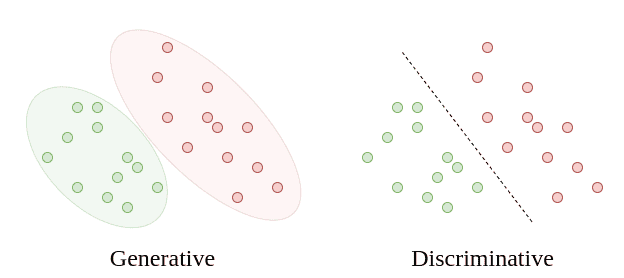1. 什么是生成模型与判别模型?
在机器学习中,算法大致可以分为两类:生成模型(Generative Models) 和 判别模型(Discriminative Models)。
这两类模型在建模目标、使用场景、优缺点等方面都有显著差异。理解它们的区别,有助于我们在实际项目中选择合适的模型,避免“用错工具”。
2. 生成模型(Generative Models)
生成模型的目标是学习数据的分布,也就是试图理解数据是如何生成的。它们不仅关注输入和输出之间的关系,还试图理解输入数据本身的结构。
✅ 核心思想:
生成模型会估计联合概率分布 ,即输入特征 x 和标签 y 同时出现的概率。
例如,Naive Bayes 算法会先学习每一类数据的分布特征,再通过贝叶斯定理计算 进行分类。
✅ 常见算法:
- 朴素贝叶斯分类器(Naive Bayes)
- 生成对抗网络(GAN)
- 高斯混合模型(GMM)
- 隐马尔可夫模型(HMM)
- 概率上下文无关文法(Probabilistic CFG)
✅ 特点:
- 可以生成新数据(如 GAN)
- 能解释变量之间的复杂关系
- 适用于无监督学习任务
- 在小数据集上收敛更快
3. 判别模型(Discriminative Models)
判别模型的目标是直接建模输入和输出之间的映射关系,更关注“怎么分类”而不是“数据是怎么来的”。
✅ 核心思想:
判别模型直接估计条件概率 ,即在给定输入 x 的情况下,输出 y 的概率。
例如,逻辑回归模型会学习一个决策边界,将不同类别的数据分隔开来。
✅ 常见算法:
- K近邻算法(k-NN)
- 逻辑回归(Logistic Regression)
- 支持向量机(SVM)
- 决策树(Decision Tree)
- 随机森林(Random Forest)
- 神经网络(ANN)
✅ 特点:
- 分类性能通常优于生成模型
- 更适合有监督学习
- 模型可解释性差(尤其深度模型)
- 在大数据集上表现更佳
4. 生成模型 vs 判别模型:对比分析
为了更直观地理解两者的区别,我们来看一个例子:判断一段文本属于哪种语言?
- 生成模型:会学习每种语言的语法、词汇分布,然后判断这段文本更像哪种语言生成的。
- 判别模型:只关注区分不同语言的关键特征,比如特定字符组合的出现频率,直接判断属于哪一类。
✅ 举个形象的类比:
| 模型类型 | 类比 | 特点 |
|---|---|---|
| 生成模型 | 学会说几种语言,然后判断 | 了解“为什么”是这个结果 |
| 判别模型 | 只学会区分语言,不会说 | 关注“是什么”结果 |
✅ 图解对比:

✅ 总结对比表:
| 维度 | 生成模型 | 判别模型 |
|---|---|---|
| 学习目标 | 联合概率 P(x, y) | 条件概率 P(y |
| 可解释性 | 强,能解释变量关系 | 弱,像黑盒 |
| 分类性能 | 一般 | 更优 |
| 数据需求 | 小数据集表现好 | 大数据集更佳 |
| 收敛速度 | 快 | 慢 |
| 收敛误差 | 高 | 低 |
| 应用场景 | NLP、医学、异常检测 | 分类、回归等监督任务 |
5. 如何选择?
选生成模型如果:
- 数据量小
- 需要解释变量关系
- 想生成新数据(如 GAN)
- 任务涉及无监督或半监督学习
选判别模型如果:
- 数据量大
- 目标是分类或回归
- 不关心模型内部机制
- 对准确率要求高
6. 总结
生成模型与判别模型各有千秋:
- 生成模型 更优雅,有解释力,适合小数据、复杂关系建模。
- 判别模型 更实用,分类能力强,适合大数据、结果导向任务。
在实际项目中,没有哪种模型是“万能”的,选择时应结合具体场景、数据规模、可解释性要求等综合判断。记住一句话:“模型不是越复杂越好,而是越合适越好。”